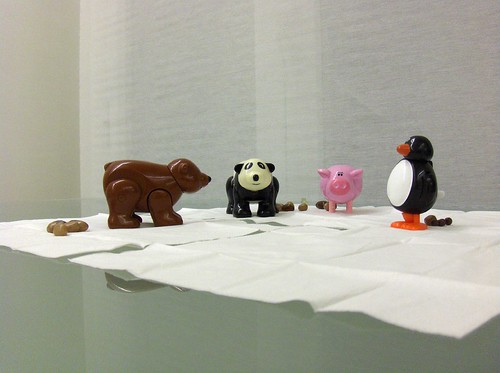Saturday, March 14, 2009
Passing of a Giant
Although I stand to benefit financially from the takeover, I find myself enormously saddened by the news. It was an extraordinary place to work, and I feel exceptionally lucky to have been a part of it. I hope to write a little more about what made the company so special in future posts, but frankly, I'm a little too choked up to do so right now.
http://news.yahoo.com/s/ap/20090312/ap_on_bi_ge/eu_switzerland_roche_genentech
Iberian Mysteries (I)
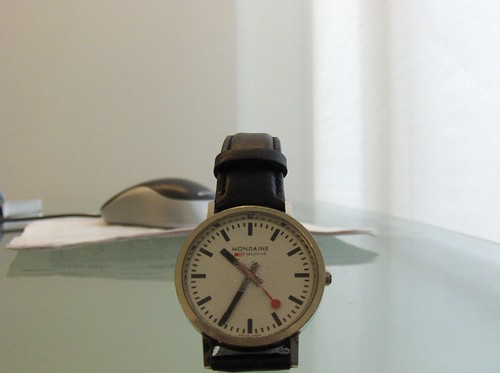
Ever since my return to Spain a couple of minor mysteries have been baffling me. The first of these concerns my watch, pictured above. If you zoom in on the picture (e.g. by calling up the 'large' or 'original' size on Flickr), you will notice something a little odd, namely a little circle of bubbles of condensation on the inside of the watch face, at the centre. This particular phenomenon started up again within 12 hours of my arriving in Spain. Its exact manifestation changes depending on the time of day, and on how long I have been wearing the watch continuously - at times it gets big enough to obscure almost the entire watch face, at times it is more of a ring than an unbroken circle, at times it is all but invisible. I say that it "started up again" because it used to happen regularly during my last stay in Spain as well. This time there is the peculiar added feature that the watch stops going altogether about once a week, which I assume has something to do with the condensation becoming severe enough to affect the battery. After leaving it off for a day or so, the watch starts up again, keeps time perfectly (though murkily) for another week, and so forth.
The mystery lies in the fact that this is a peculiarly Spanish phenomenon. The watch works perfectly the rest of the time, with no visible condensation problems. In Guanajuato last year - no problem. Similarly, for the seven weeks I was in Buenos Aires, the watch worked perfectly. But within 12 hours of arriving in Spain, it's weeping like the statue of some kind of cheap plaster saint in an Andalucian church. In 2007 this happened not only in Madrid, but in Sevilla and Granada as well (though not to the point of stopping entirely). Oddly enough, there were no problems in Salamanca.
I assume it has to do with some odd combination of perspiration and the local ambient conditions, but am at a loss to understand exactly how such a phenomenon might work. Or its bizarre geographical specificity.
Friday, March 13, 2009
My first video
Believe me, I am not particularly proud of the fact that the first video published to my blog involves a penguin-pooping confectionery dispenser.
But then, there are a lot of things in my life that I am not particularly proud of. The worst part is that, as one grows older, the number just keeps increasing. It's not clear why one's most shameful moments should be preserved forever in memory, as if in amber, but that appears to be how things work.
El ingenioso hidalgo Don Quijote de La Mancha
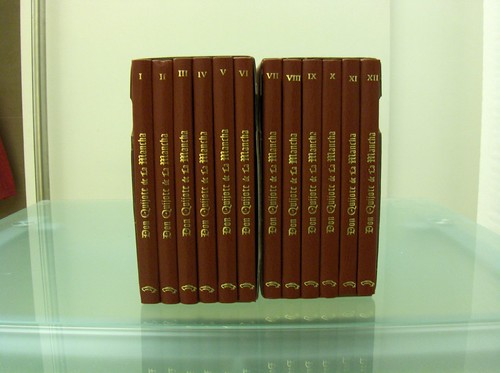
The price was right - a paltry 10€ - and the convenience of the 12 slim volumes appealed to me. So I decided to take the plunge. During the transaction, I was making small talk with the book store clerk about the feasibility of a foreigner making it through the entire set in the original Spanish. He was encouraging, saying that they sold copies in Spanish to foreigners all the time, and that just yesterday they had sold a copy of the very same edition I was buying to Viggo Mortensen*.
I think this may be just the impetus that I need. Knowing that I may be reading it in parallel with Aragorn, son of Arathorn, is quite motivating.
*What he failed to mention was that, according to Wikipedia:
His family moved to Venezuela, Argentina, and Denmark, settling in Argentina, where he learned Spanish and became a fan of Club Atlético San Lorenzo de Almagro. His father managed chicken farms and ranches in Argentina. They remained there until Mortensen was eleven
which gives Viggo a certain advantage, as far as navigating the Spanish is concerned.
But still. I am oddly motivated.
OPERATION BAKED GOODS REDUX
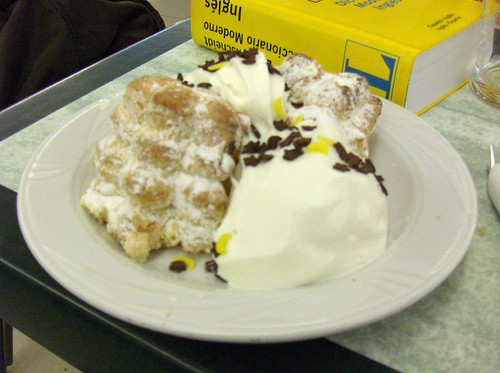
The latest entry in our parade of decadent desiccant dulces is shown in the photograph. The pastries in question are known as "nicanores", and are native to the little pueblo of Boñar, which is -- as far as my lazy, google-based research has been able to ascertain -- somewhere not too far outside of Madrid, in the province of (Castilla-)León.
It seems only fair to allow the Nicanores a chance to give their side of the story -

The Nicanores are an exquisite puff pastry which the main row material is the butter. After a caring manipulation, they have turned into a puff pastry of a extraordinary quality as the smooth of their layers make them so delicate that they get dissolved in your mouth in the same way that it happens with the own butter.
Here at Operation Baked Goods Central, our standards have to be a little higher. (Our readers deserve no less). Our reviewer's opinion:
Although the nicanores share the unique desiccant properties common to all eThpanish baked goods, eating them was not an entirely painful experience. The saliva-absorbency did not quite reach the levels of the little desiccant packages found in new luggage, and the cardboard taste that is regrettably common in the pastries of the Iberian peninsula was refreshingly absent. They were, however, extremely friable, reaching the maximum 5 points on the flakiness scale. Consumption was definitely aided by the large dollops of "nata" shown in the picture, though it is this reviewer's opinion that the "dairy product" in question was definitely closer to Kool-Whip (sic) than actual whipped cream. However, its presence had a definitive ameliorative effect on the consumability of the nicanores, and extra points are due to the restaurant for providing the entertaining little sugar stars as decoration. Sadly, none of this was enough to make a person ever want to eat this particular delicacy more than once in a lifetime.
The pastry chefs of Vienna, indeed of all of Northern Europe, have little to fear from this Iberian delicacy.
Although the name suggests that this pastry might be a particular favorite of suave, martini-swilling, couples with a taste for sleuthing, this appears to be nothing more than a lexicographical coincidence.
Wednesday, March 11, 2009
Segovian shenanigans
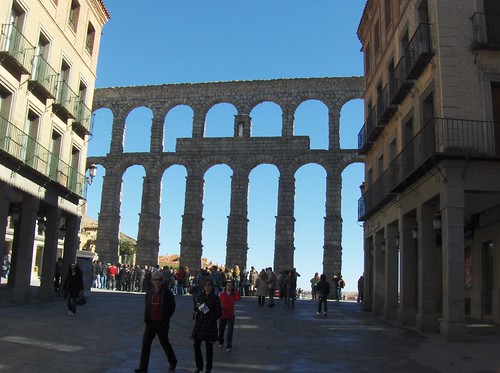
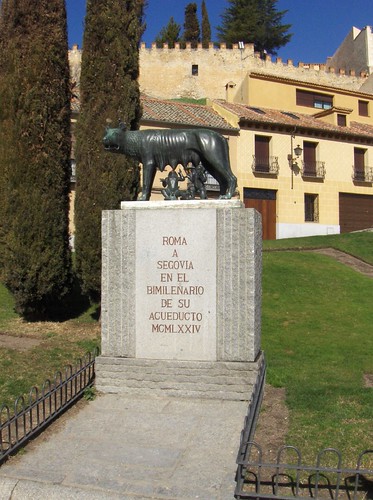
its delicious local culinary specialty, the cochinillo, or suckling pig (YUM):
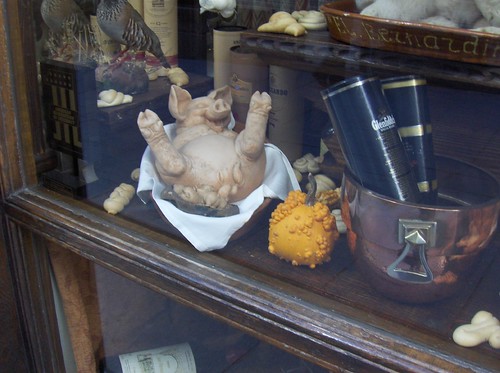
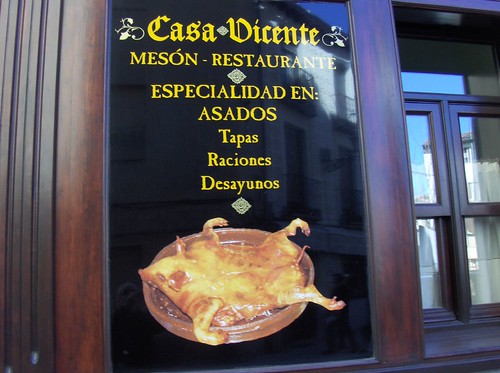
and assorted historical sculptures and statues:

There's also the Alcazar, the Cathedral, and about a gazillion other churches, though - it pains me to break the news - the museum of witchcraft closed last year due to poor attendance.
Nonetheless, Brad managed to track down what might reasonably be considered the most hideously inappropriate, ugliest souvenir your imagination could possibly conjure up. As this is a family blog, more or less, it is entirely impossible for me to provide photographic evidence. Let's just refer to it as a carved wooden "male fertility idol", and if that doesn't conjure the right kind of graphic image in your mind, perhaps the words "grotesquely oversized genitalia" will do the trick.
Now, far be it from me to criticize the souvenir choices of any of my houseguests, though frankly, my slight (and understandable, if you saw the bloody monstrosity) embarrassment when he insisted on roping me in as an interpreter during the purchase seemed to provoke an unnecessary amount of glee on his part.
Tables were turned when we got to the station on the way home, however, because all the bubble wrap in the world won't save you from embarrassment when you have to put your fertility idol with the grotesquely oversized genitalia through the X-ray screening machine required to board the train from Segovia to Madrid. I'm ashamed to admit that the one doing the gleeful cackling at that point was me.
We had a great day in Segovia.
I'm pleased to say that I managed to convince Brad that it wasn't really necessary to take the idol out of its bubble wrap for the cleaning lady's benefit yesterday
Tuesday, March 10, 2009
New York, New York



Here is the link to the Telefónica website:
http://www.fundacion.telefonica.com/arteytecnologia/exposiciones/weegee.htm
Bizarre confectionery dispenser dioramas

There is no satisfactory "explanation", except to say that boredom on a Sunday evening and way too much time on my hands contributed to the first in this series. Before I could stop myself, a tradition was born, and now Sunday would seem incomplete without assembling another one and posting the photographic evidence. I am worried that the polar bear dispenser planned for next weekend appears to be temporarily out of stock, but hopeful that the situation can be remedied before Sunday rolls around.
Yes. It's true. I am 8 years old. Given the right headgear, I could be a South Park character.
He lives in the coffin. He drinks of the blood.
Despite that promising opening, there are no major confessions to follow - sorry to get anyone's hopes up. But a small illustration is provided by my behavior in restaurants and cafés. Back in the U.S., my preferred interaction with waiters is to as cordially brief and to the point as possible, a probable reaction against the "waiter as buddy" model adopted by far too many eating establishments. Here in Spain, it's quite the reverse - I will engage even the surliest of waiters in conversation. Partly it's a desire to see if I can make a dent in the surly exterior, partly it's because the reason I'm here is to converse with Spanish people (so waiters qualify). It helps to know that one is anonymous - what have I got to lose - and there's always a readymade excuse. Since I generally have something that I'm reading, underlining the unknown vocabulary words, if nothing else I can always ask what a particular word means.
The answers to this opening line can range from brusque and boring to engaging and entertaining. One of my favorite recent responses was in answer my asking the meaning of the word "ataúd". The waiter puzzled for a moment as to how best to explain, then broke into a wide grin and explained:
"El ataúd es donde vive el Conde Dracula" (it's where Count Dracula lives).
I couldn't have put it more succinctly myself.

The little coffin shown in the picture is on display in the Alcazar, the old fortress/museum that is one of the highlights of Segovia, which we visited on Sunday. The story that goes with it is a sad one. At some point in the castle's history, a particularly unlucky royal nanny had the misfortune to drop the baby princeling in her charge from the ramparts. Rather than face disgrace and certain death as punishment, she flung herself to her death after him. The coffin is alleged to have contained the little royal remains (seems kind of unlikely). One imagines that the nanny's remains fared less well.
